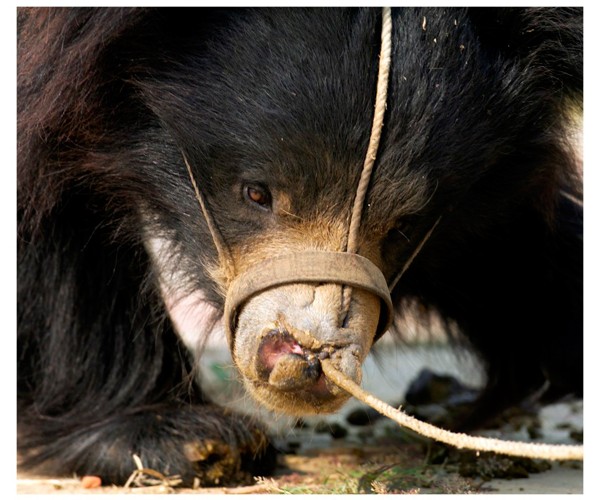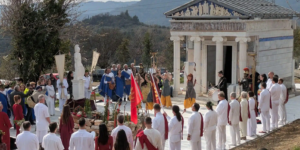Early on, WSOS understood that to save the bears, they would have to first rescue the Qalandars. “I realized that the community was trapped in a vicious cycle, believing that they could not do anything else for their livelihood,” said Satyanarayan.
 Two dancing bears. Photo courtesy of WildlifeSOS-India. |
What began as an investigation into this centuries-old practice slowly catapulted into a country-wide movement that rescued more than 500 bears. Consequently, four bear rescue centers were created across India – in Agra, Bhopal, Purulia and Bangalore. The Bangalore center was where we were headed.
After a steady two-hour bus ride through Bangalore’s packed streets, we reached the Bannerghatta Bear Rescue Centre (BBRC), nestled within the lush forests of Bannerghatta National Park.
Home to 86 dancing bears rescued from Karnataka and West Bengal, BBRC runs under the watchful eyes of Dr. Arun, the Director of Research and Veterinary Operations, who has spent the last eight years here. He showed us around his enviable workplace, nonchalantly walking past bear enclosures, while we tentatively followed.
In our minds, bears have always conjured images of lethal, ruthless and unrelenting strength. Yet, we often found ourselves stifling a giggle. The sloth bear’s shaggy coat blooms into a comical mane around its large head. Surprisingly lanky, they clumsily walk around on all four, their fur rocking from side to side. Their muzzles are disproportionately long. And they have personality.
 Kartick Satyanarayan with a rescued bear. Photo courtesy of WildlifeSOS-India. |
“They are the dons of our centre,” says Arun pointing to a group of adult sloth bears in an enclosure. “They don’t get along with anyone. They are nice to each other, but if they come across any other bear that doesn’t belong to their group, they gang up on him and chase him away.”
As impressive as these “dons” might seem, they have a rather embarrassing weakness.
Arun takes a handful of water and flings it at Deva, a bear with a tilak-like mark on his forehead. Deva immediately shudders and runs away from the gate, the scraggy fur on his back seesawing.
We walk into the “bear-kitchen” with Arun, where a large cauldron of porridge simmers on a stove. “One minute. That’s all each bear needs to finish off seven kilos of porridge,” says Arun. “They suck like vacuum cleaners.” We wait for Arun to wink and tell us that it’s just a “Goldilocks and the Three Bears” joke he throws at everyone who comes visiting, but instead he goes on to tell us that each bear polishes off 10-14 kilos of porridge every day.
In a forested patch near the bear kitchen, Kashi, an adult male bear, is asleep amidst the thick undergrowth. Sensing intruders, he lifts his head to survey us before going back to his slumber. Arun smiles approvingly.
 Babu, a Qalandar turned bear keeper at BBRC. Photo courtesy of Shreya Dasgupta. |
Nocturnal in the wild, these sloth bears had to reverse their natural routine during their dancing days. So seeing a bear asleep during the day is delightful proof that they haven’t lost all of their “wild” instincts.
In fact, the freedom of the forest has restored more instinct than just lazy days and active nights. Sometimes they can be found sitting in the trench around the rescue centre, where they create fascinating designs with their claws. In the evening, they playfully run havoc, swinging from hammocks tied to tree trunks, jumping over strong wooden platforms and living up to their reputation of being champion tree climbers. “I have seen two of them go to the top of a tree, to the thinnest of the branches, and fight. They have that level of maneuverability,” says Arun.
BBRC almost seems like a school crèche. Each bear has a distinct, mostly endearing personality. Those with matching temperaments usually huddle together in an enclosure, each with its own befitting name, such as Bali and Sugreev, two male bear cubs in the Kishkindha enclosure.

Geeta Seshamani with a Qalandar and his bear. Photo courtesy of WildlifeSOS-India.
While the WSOS camp may be the land of milk and honey for the bears, we see depressing glimpses of the lives they once led. Like many others, Kashi’s face still bears the marks of the rope that once pierced through his muzzle. And the mental scars may never heal. We see two bears rocking from side to side, their range of movement stifled by some invisible constraining device. It’s as if they still believe in their heads there’s still a short rope running through their face, with a Qalandar at the end of it.
We anticipated these stories of survival, perseverance and reprehensible human actions. But WSOS’s greatest success lies in its grandest tale, that of human rescue.
The Qalandars are a group of nomads that missed the bus to modern jobs and a better life. Their only fault was bearing the brunt of tradition. They bought their cubs from poachers, who would kill the ferociously protective mother bears to get to the cubs. Their training regimen had a cruel initiation. The bear’s canines were removed, their muzzles were pierced with a heated nail and a rope was passed through it. If the cub was male, it was castrated.
It’s easy to cast the Qalandars as villains. But that would be a projection of our urban “morality,” one that says it’s okay to scare a dog into learning how to sit and roll-over, but not okay to teach bears how to dance. And it would do disservice to WSOS’s delicate solution to a problem conveniently brushed under the carpet by lawmakers and authorities.

Qalandar making a bear dance. Photo courtesy of WildlifeSOS-India.
Babu, a young Qalandar, no longer lives the life that was his to claim. Now 26, he lives with his family near BBRC in a rented house, and works a regular shift – 8 a.m. to 6 p.m. – like any office-goer. He has been a bear handler here for the past seven years, looking after the very dancing bears he and his kin once owned. But as a child, this was perhaps not the life he had envisioned.
Babu speaks in a deliberate, matter-of-fact way. He doesn’t shy away from his past, nor does he try to defend it. Instead, he tries to explain what it was like to grow up as a Qalandar.
“We never thought of getting another job, or going to school,” he says. “And anyway, when our parents would go from village to village with the bear, we would have to go with them. So we couldn’t stay at home and study.”
Babu hails from a Qalandar village in Bellary district, Karnataka, about 310 kilometers (193 miles) away from Bangalore. He grew up with two bears, Raja and Dhanush, that are now at BBRC. Babu had no qualms making bears dance. He, in fact, found it fun for the most part. It fetched his family about $6 to $8 per day. The whole process of training the bears, he says, was something he would look forward to.
“We’ve had bears for several generations. I’ve seen my family making bears dance since I can remember. That was our job – get a bear cub, raise it and make it dance. That was it,” he says.
For Babu, giving up his bears was not very difficult. In exchange, he received a job at BBRC, a “settled life” and almost $800 for each bear. “Although initially I was a little disappointed at having to give up my bears, I was very happy to have finally gotten a job that earns me more respect,” he tells us.
In India, owning bears is punishable by a prison sentence, as per the Wildlife (Protection) Act of 1972. However, Babu claims that he was not fully aware of the legalities. “I didn’t know this was illegal. Sometimes people would tell us this is wrong. And sometimes the forest department staff would catch us and question us, but we would pay them some money and they would let us go,” he says.

The ‘DON’ bears in an enclosure at BBRC. Photo courtesy of Shreya Dasgupta.
His parents now work on their agricultural field. His brothers drive autos. While some people in his village do still grieve the loss of their traditional occupations, many others are relieved to now have other sources of livelihoods, such as shops, fields and other small businesses – mostly through WSOS’s monetary and logistic support.
But despite the seven years Babu has spent as a bear keeper at BBRC, Raja still doesn’t like him. “Dhanush is fine with me. But if I go near Raja, he gets very annoyed,” says Babu. Of the 13 bear handlers or keepers at BBRC, nine are Qalandars.
Arun takes us to the rescue center’s lab, a room just large enough to house a few microscopes, a cupboard full of medicines and some bear lungs in glass cases. These massive lungs are from bears that died of tuberculosis, deaths that have left Arun perplexed. “The bears don’t show any classic symptom of tuberculosis, and they refuse to take anti-TB medicines,” he says.
Tuberculosis is just one of the diseases the bears seem to have acquired from their prolonged contact with humans.
Their canines hacked off by the Qalandars with all the finesse of an apprentice carpenter, sloth bears also become susceptible to gum infections and even oral cancer. For the sloth bears, who need to close their mouths to suck up food, such oral disease can be devastating, possibly fatal.
And not all the bears look their age. Years of captivity has stunted growth, making some old bears look like cubs. In addition, many have aggression problems.

Kashi, a rescued bear, resting, at BBRC. Photo courtesy of Shreya Dasgupta.
Lakshman is one such bear. Still aggressive, even the bear keepers are wary of him, and we can feel his edginess. The moment we walk past his enclosure, he lets out a loud roar and bangs against the (thankfully) locked enclosure gate.
“But most of the bears here are like ‘tame pets’,” says Arun. “Definitely not like their ferocious wild counterparts at all. In fact, the wild bears can climb up and down the steep wall of the trench. None of our bears can do that.”
But while the trench keeps these rescued bears safe from the world, are other sloth bears completely freed from their jobs as dancers?
“We do receive telephonic reports from animal lovers and members of the public about dancing bears. But to date, no such reports have yielded any concrete results and are usually hearsay,” says Satyanarayan. “In one case, the caller confessed later that it was a large black goat that she had initially mistaken for a bear.”
WSOS set out to save bears. Fourteen years later, they have liberated a community. They broke a vicious cycle by educating children and making Qalandar women breadwinners. They instilled pride in the men.
As for the bears, BBRC’s staff made sure we couldn’t help but fall in love with them. The rescue center is a sincere apology. The dancing bears can’t be released to the wild, so they live here, where they can climb all the trees they want and eat all the porridge they’d like. All in the hope that when the last dancing bear dies, our collective conscience will feel a little lighter, because at least we tried to make it up to them.































